
Transforming government post–COVID-19 How flipping orthodoxies can reinvent government operating models
27 minute read
15 June 2020
COVID-19 has forced governments to respond nimbly to rapid change—leading them to challenge some deeply held beliefs on how they should operate. Here are 10 changes that might be permanent for government.
The old normal won’t work anymore
Governments around the world are beginning to reopen not only their economies but their own offices and operations. And, as with private businesses, they’ll be reopening in an entirely different operating environment—and will have to adapt to the new reality.
Learn more
Read the executive summary
Download a summary slide presentation
Learn more about connecting for a resilient world
Explore the government & public services collection
Learn about Deloitte's services
Go straight to smart. Get the Deloitte Insights app
Many aspects of prepandemic operations will be difficult or impossible to resume, at least in the near term. From motor vehicle offices to court hearings to physical inspections, governments will have to find different methods of service delivery.
In many cases, the mission in the post–COVID-19 environment will be evolving as well, with new functions such as disease monitoring and the regulation of social distancing edicts.
Governments will need to adopt a new operating model based on the uncertain environment we now live in the “next normal” of work. But what should it look like? What should governments stop doing and what should continue from the COVID-19 response? How can they radically accelerate some current developments such as digitization?
These questions can be examined by what some call “flipping orthodoxies.” We all have these “orthodoxies,” deeply held beliefs about how things should be done that often go unstated and unquestioned. They often spring from useful standard practices. But they can also cause dogmatic resistance to change, preventing us from seeing new and better ways to work.
The response to the pandemic is highlighting many of government’s orthodoxies. Examining and flipping these could lead to significant improvements. Governments should strive to transform their operations not only in health care but in areas like service delivery, workforce, regulation, and procurement.
Governments should strive to transform their operations not only in health care but in areas like service delivery, workforce, regulation, and procurement.
In this report, we examine 10 government orthodoxies being challenged by the pandemic, and how flipping them could lead to greater mission value, developing a culture of innovation, a better experience for citizens, businesses, and employees, and revamped postpandemic operating models (figure 1).
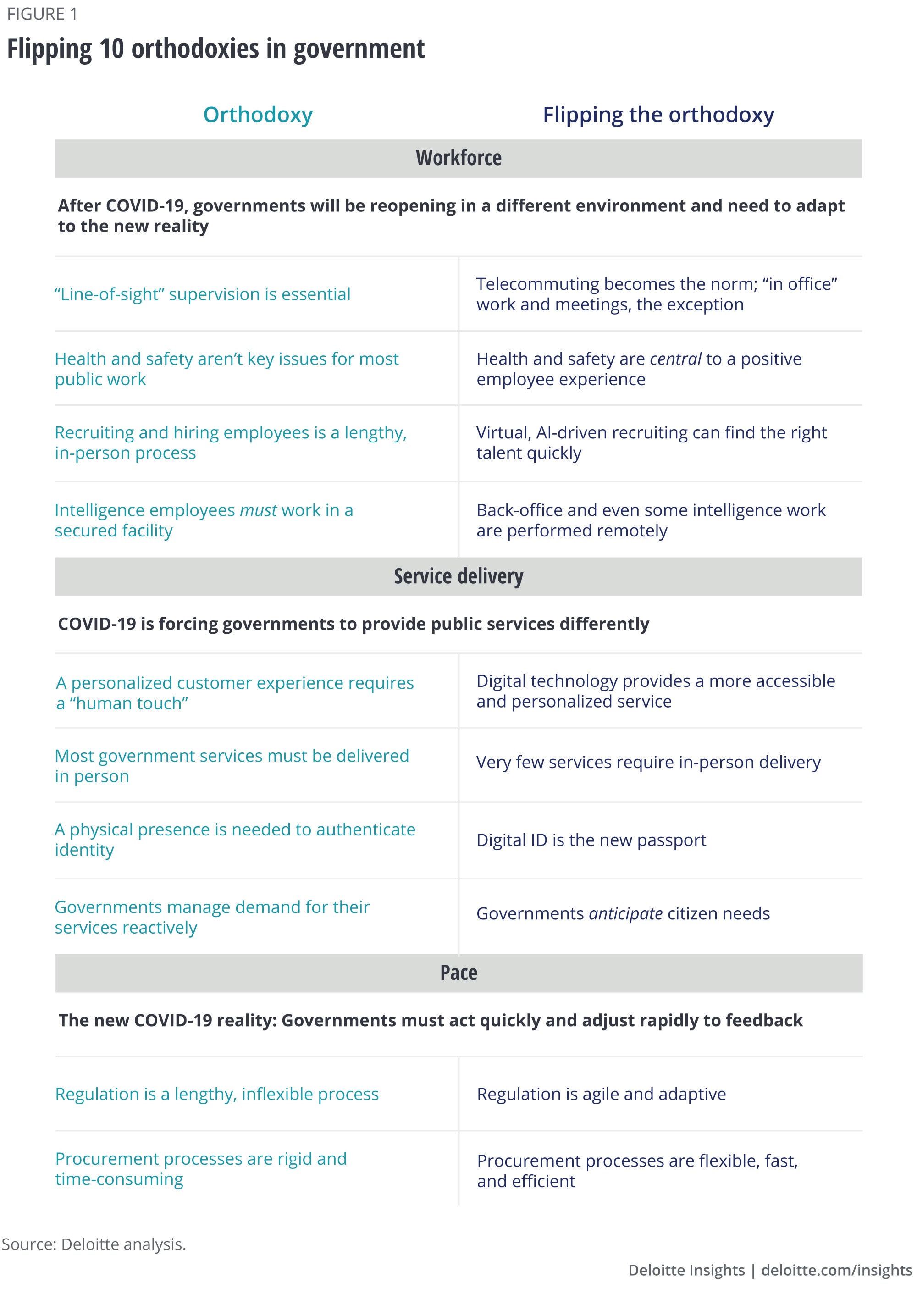
A short introduction to orthodoxies
Orthodoxies are neither inherently good nor bad; many simply represent the best practices of previous eras. But failing to recognize and challenge them can impede innovation, restrict risk-taking, and, in this case, impede the reopening of government operations.
Walk-in offices with regular hours, for instance, made sense in the predigital era; citizens knew exactly when and where to go to access government services. Today, however, when citizens can interact with governments online, work schedules requiring workers to staff physical workplaces from 9 to 5 may not be necessary or even desirable.
Disruptions such as the one we’re experiencing today can—and should—encourage us to reconsider orthodoxies. Challenging circumstances may highlight aspects of orthodoxies that represent bottlenecks or constraints. In the face of urgent needs, individuals tend to be more willing to take risks and institutions often prove more flexible. Figure 2 offers some well-known examples of orthodoxies that were flipped.
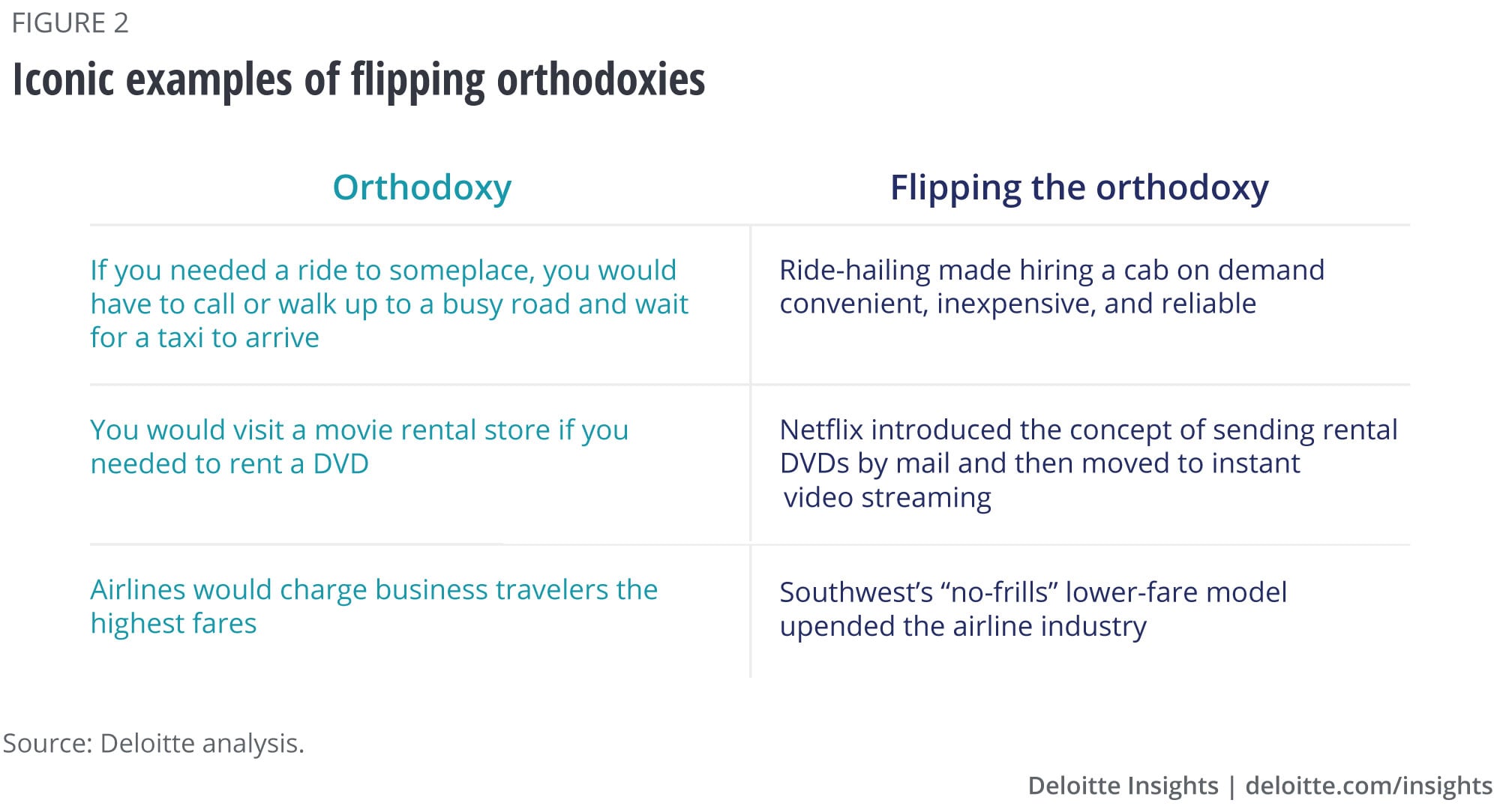
Workforce and workplace
Governments are reopening in a different environment and need to adapt to the new reality.
Reopening government will not mean returning to business as usual; the next normal will be different. COVID-19 has disrupted nearly every area of government, from public transit to welfare services to law enforcement.
Demand for public transit, for instance, has nose-dived by as much as 75–85% during the pandemic, in areas such as Washington, DC, Copenhagen, and Buenos Aires.1 As of the end of April, Transport for London reported that the number of passengers carried has dropped by 95% on the tube and 85% on buses—and has furloughed approximately 7,000 staff members.2 Police forces are becoming short-staffed, as more and more officers are diagnosed with COVID-19 or asked to stay at home due to their age or preexisting health conditions. Mumbai has asked 7,500 policemen aged 55 or older to stay at home—15% of this enormous city’s police workforce.3
Yet COVID-19 also presents governments with an opportunity to accelerate their transition to the future of work. We’ve seen many signs already. The rapid shift to telework, rapid hiring of essential workers such as contact tracers, virtual training, and revamped workplaces have shown that decades-old orthodoxies can be broken (figure 3).
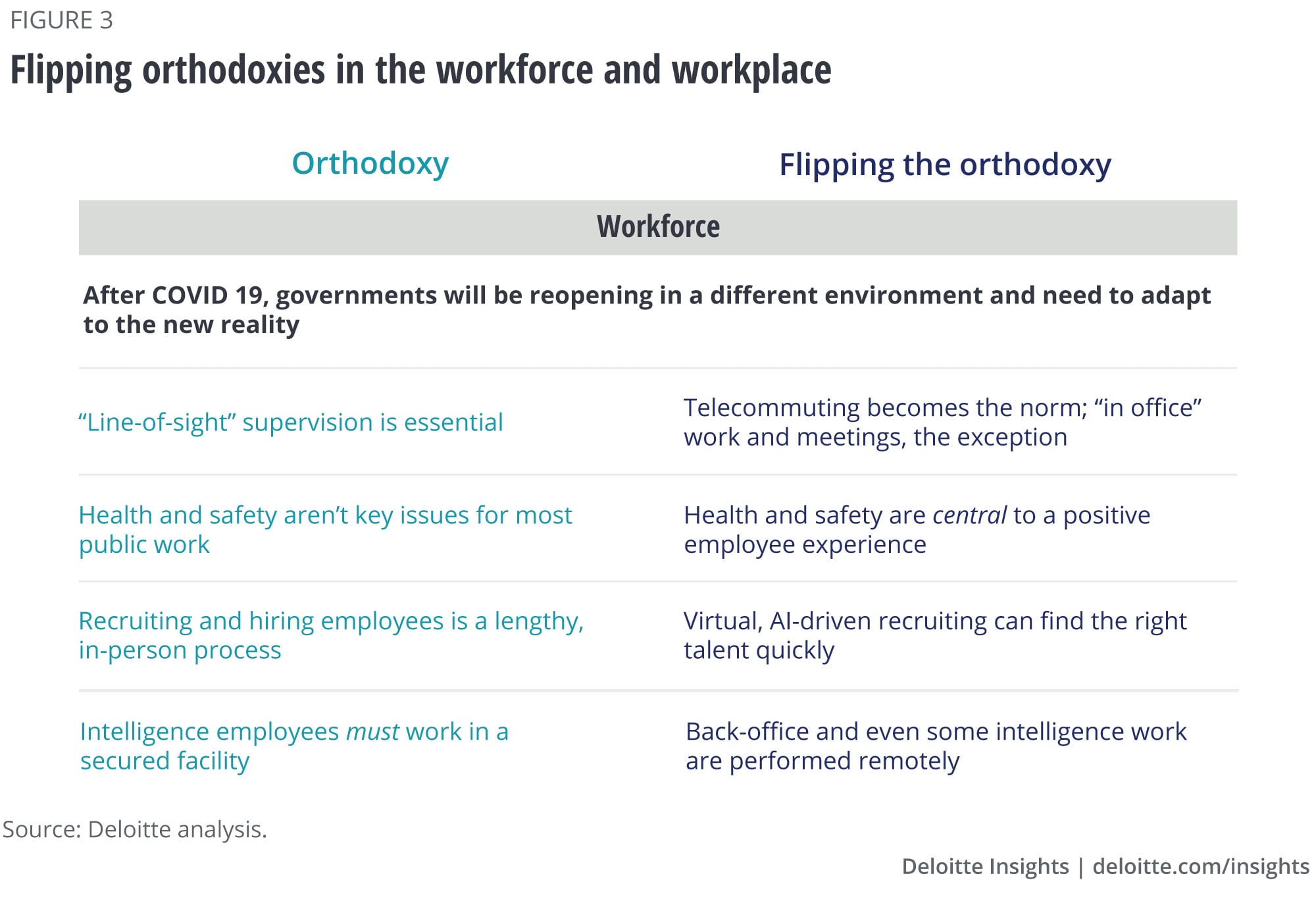
Orthodoxy 1: “Line-of-sight” supervision is essential
Traditionally, government workplaces have worked on standard schedules. Some jobs still may require an onsite presence, for security or other reasons; many others may not. Before the pandemic, most government employees not in the field worked onsite simply because they always had. As of 2019, for instance, only 42% of the US federal workforce were deemed eligible for telework.4 Many government contract workers have clauses in their contracts that require an onsite presence.5 In Japan, one poll indicates that 83% of companies didn’t permit work from home before the pandemic.6
Reducing or even eliminating commuting times can lead to greater productivity. A study of more than 34,000 workers across all industries in the United Kingdom found that those commuting less than 30 minutes daily gain an extra seven days’ worth of productive work each year.7
Flipping the orthodoxy: Telecommuting becomes the norm; “in-office” work and meetings, the exception.
COVID-19 presented most of the world with a test: Could work as we know it continue in a virtual environment? This grand experiment not only pushed operating protocols, policies, and infrastructure to their limits but also mainstreamed concepts such as telework, telehealth, and online learning.
As governments begin reopening, in many cases remote work may become their new normal, in a long-term, nationwide transformation. The US Department of Defense (DoD), for example, plans to keep many of its enhanced telework capabilities for the long term. Each of its services has expanded its telework capabilities dramatically. The US Army has seen a 400% increase in remote network capabilities. The US Navy plans to double its remote workforce from 250,000 to 500,000, while the US Air Force has taken steps to increase its network bandwidth by 130%.
The DoD plans to keep these capabilities post–COVID-19. “The way we work has changed dramatically,” says Dana Deasy, DoD’s chief information officer. “There is going to be an enhanced teleworking capability that will be sustained at the end of COVID-19.”8
Some European countries were expanding telework options long before the pandemic. Fully 75% of government workers in Denmark, Norway, and the Netherlands can opt to telework.9 Many workers believe that telework increases their well-being, improves work/life balance, enhances job satisfaction, and reduces stress. Teleworking can also result in cost savings from better real estate management. With remote work, the talent pool for government can also be more geographically decentralized, enabling government agencies to recruit from more diverse workforce pools.
Innovation accelerators facilitated by governments traditionally have relied on physical space and proximity. In the wake of the pandemic, governments are setting up digital testing environments for innovators to test and develop proofs of concept. The United Kingdom’s Financial Conduct Authority is accelerating efforts to set up a “digital sandbox” and plans to conduct a pilot on COVID-19–related challenges.10
Determining who goes back to the office—and who doesn’t
Millions of organizations around the world are asking these questions as they consider returning to workplaces:
- How can we decide who should return to the physical workplace, in view of external factors, specific job requirements, and worker preferences?
- How can we adjust technology, policies, skills, duties, performance management, and collaborative tools to launch a blended (colocated and virtual) workforce in the next 12 to 18 months?
Figure 4 provides a decision-making framework for answering these questions, balancing the feasibility of remote work against public health risks. Governments should be gathering the data they need now to understand what works well virtually and what doesn’t, so they can make intentional choices about specific positions.
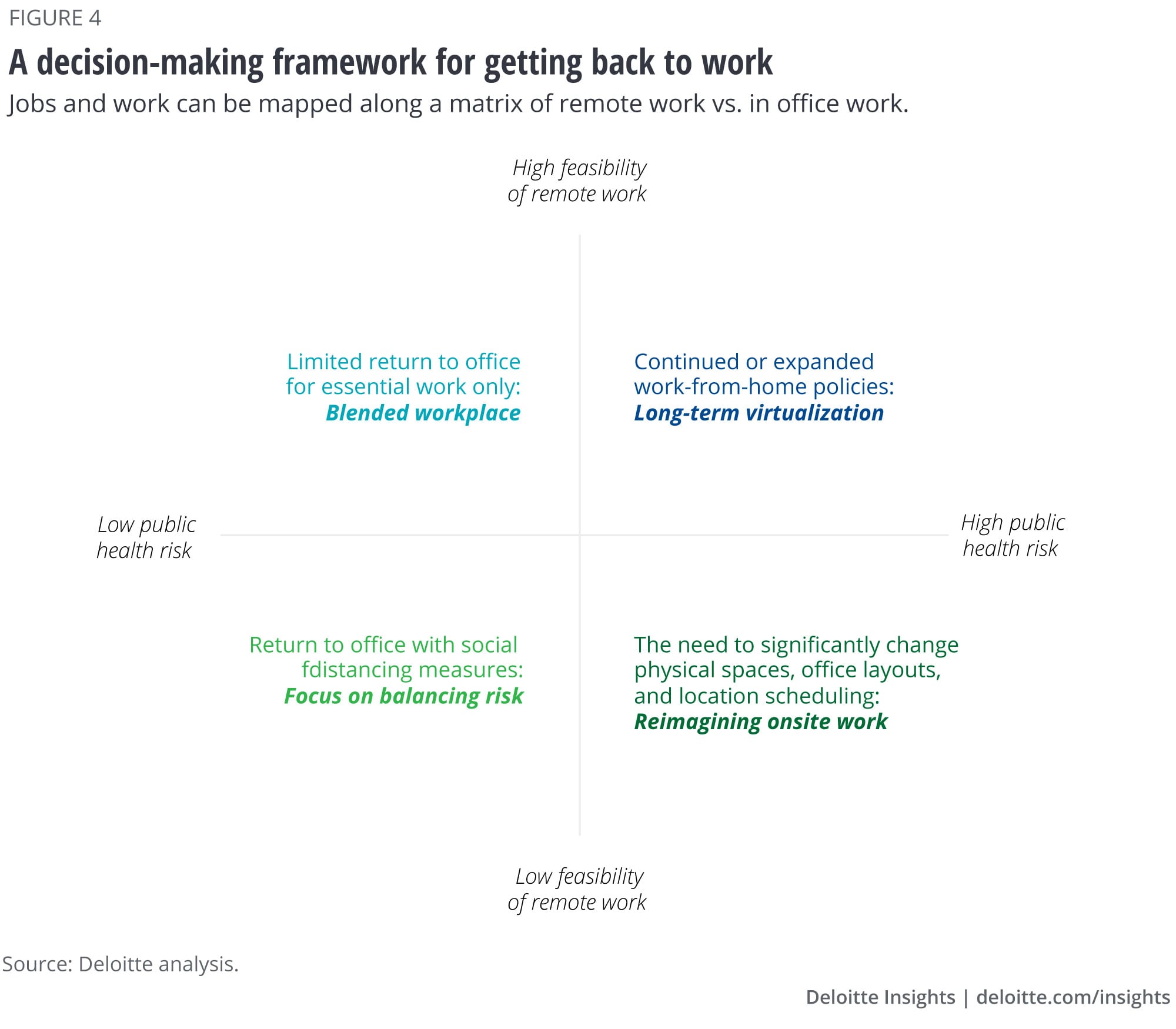
Orthodoxy 2: Health and safety aren’t key issues for most public work
COVID-19 has brought worker health and safety to the forefront. Obviously, police and fire departments and prisons already focus deeply on these issues. For most nonhazardous roles, however, it simply wasn’t a central consideration before the pandemic. The 2017 Workplace Health in America study, for instance, surveyed more than 2,800 for-profit, nonprofit, and government employers and found that only 46% even had health and wellness programs.11
Flipping the orthodoxy: Health and safety are central to a positive employee experience.
In the postpandemic world, employee safety will be a top concern for government. Physical workspaces must be reenvisioned to emphasize health and safety and maintain social distancing. This will require agencies to maximize the availability of telework opportunities and invest in digital tools that enhance the employee experience.
Diagnostic and antibody testing for COVID-19 will become routine. New disinfection protocols will be needed at workplaces and schools and in public transit. The Danish government, for example, currently advises hand-washing for schoolchildren every two hours and allows only three to five children at a time on playgrounds.12 Austria has required the use of face masks for public transport.13
But such protocols alone won’t be enough. The emotional and mental well-being of employees will become a driving factor. According to the United Kingdom’s Health and Safety Executive, teachers and education professionals report the nation’s highest rates of work-related stress and anxiety.14 An American Medical Association survey of 1,257 health care workers across 34 hospitals in China, conducted January 29–February 3, shows that many of them were experiencing symptoms of depression (50%), anxiety (45%), and psychological distress (72%).15
Governments have begun taking steps to address these mental health issues. Even before COVID-19, the UK National Health Services (NHS) made health, well-being, and mental health a priority for its employees.16 In light of COVID-19, the NHS partnered with three organizations to offer free mental health mobile apps to its health care staff.17 In Canada, British Columbia offers an online resource hub to provide information, training, and webinars to support the mental well-being of its workers. The province also offers health and safety workshops for its workers, covering areas such as mental health, mindful communication, change management, resilience, and stress management.18 The Australian government earmarked AU$48.1 million for mental health and well-being, prioritizing outreach, and connectivity of the community.19
“Front-line health care workers are working tirelessly to keep us safe and healthy during this unprecedented time, and they deserve support for their mental health now more than ever,” says Judy Darcy, provincial minister of Mental Health and Addictions of British Columbia.20
Orthodoxy 3: Recruiting and hiring employees is a lengthy, in-person process
The traditional approach for government hiring requires in-person interviews with numerous individuals, with subjective assessments about experience, character, and ability. The approach can take months and, at times, places more emphasis on process than hiring the right talent quickly.
Flipping the orthodoxy: Virtual, AI-driven recruiting can find the right talent quickly.
The pandemic is changing how government agencies attract and recruit staff. To speed up the hiring process, governments have offered more flexibility to agencies or temporarily suspended normal hiring rules. The US Office of Personnel Management (OPM), for example, now allows agencies to bypass the normal, lengthy process for new hires for COVID-19 work. In the US federal government, executives can recruit former federal employees without a full competitive hiring process.21 Federal agencies also can apply for dual compensation waivers to rehire retired workers.22
The federal Intergovernmental Personnel Act and other talent-exchange programs provide opportunities to temporarily incorporate the expertise of employees across levels of government and from academia, nonprofits, and the private sector. Government executives should encourage the movement of employees across different agencies to exchange knowledge and skills.
The US Department of Agriculture’s (USDA) Economic Research Service (ERS) and National Institute of Food and Agriculture (NIFA) have partnered with the University of Missouri to host a virtual career expo to fill openings for a range of occupations, from economists to accountants. “This is a unique time for our nation, and USDA continues to build the ERS and NIFA workforce using innovative techniques,” says Deputy Undersecretary Scott Hutchins, who leads USDA’s research, education, and economics mission area.23 Similarly, governments are hiring contact tracers virtually. The state of New York requires potential contact tracers to pass an online exam to secure the job.24
Artificial intelligence (AI) can help, too, by screening applications to identify behavioral, cognitive, and cultural characteristics and performance potential, drastically reducing time requirements. Virtual interviews and online onboarding can further speed up hiring. OPM has advised agencies to onboard staff virtually to maintain social distancing.25
Of course, new hires must be trained for their roles. While online learning is fairly common today, it often embodies many orthodoxies of the brick-and-mortar classroom, such as live teleconferencing or recorded lectures. New technologies such as virtual reality (VR) offer a chance to challenge these as well (see sidebar, “COVID-19 and reimagined training”).
COVID-19 and reimagined training
The COVID-19 crisis is forcing agencies to shift to virtual learning platforms for training. These systems can create individualized learning plans for each participant, with digital content, VR games, experiential learning, exercises, and interactivity. USDA’s Food Safety and Inspection Service, for instance, has begun using VR to transform a traditional classroom course on public health veterinary. It has developed engaging, immersive experiences, such as the opportunity to view an inspector’s work setting in a 360-degree VR interactive training environment. Similarly, USDA has developed an immersive VR experience of slaughterhouse inspection to help potential hires understand the job’s real-life environment.26
Other organizations have also turned to VR. One hospital in Los Angeles has used VR to train more than 300 doctors to assess coronavirus symptoms.27 The George Washington University hospital uses VR imaging technology to assess the extent of infection in patients’ lungs.28 An Italian hospital is deploying VR to relieve stress on medical staff, using visualization, guided breathing techniques, and associated feelings of positive memories.29 VR technology also can be used to conduct “face-to-face” meetings, extending physical avatars virtually to a specific venue or event.30 These avatars also can help in recruitment and immersive training.
Orthodoxy 4: Intelligence employees must work in a secured facility
Strict control of and access to classified information is common across governments. A nation’s most important secrets are stored in sensitive compartmented information facilities (SCIFs), on secure networks, and in safes. Access to this information is granted only to those with security clearances and “need to know” access. For the portion of the workforce that must access classified information, the workspace is restricted to SCIFs and other high-security locations.
The physical isolation of intelligence workers, however, can have unintended side effects. First, many employees must work in secure facilities even if their work is not in itself classified, such as human resources, procurement, and other necessary back-office tasks. Having these back-office functions take place on classified systems can make it difficult for employees to do simple things such as change benefits selections. Requiring a security clearance for such roles also reduces the talent pool and can limit workers’ ability to collaborate with commercial, academic, or other external partners. Second, for those doing actual intelligence work, controlled physical spaces subtly magnify the importance of classified information, often leading them to undervalue other sources of intelligence.
COVID-19 and the subsequent workforce crisis have shown us another way.
COVID-19 and the subsequent workforce crisis have shown us another way.
Flipping the orthodoxy: Back-office and even some intelligence work are performed remotely.
For workers who don’t typically deal with classified information, the sudden shift to remote work has required them to begin disentangling unclassified work from classified systems. This has created an opportunity to tap new talent and find new partners with new skills. An HR system, for instance, could be tested by top white-hat hackers; realistic training sessions could be created by top video game companies.
The same principles can even be applied to core intelligence tasks. For years, many within the intelligence community have begun to realize that some of the most useful data comes from public and commercial sources. A larger presence on unclassified networks could allow intelligence professionals to delegate portions of their analysis to top academic and industry partners. For example, external partners could analyze social media, leaving intelligence personnel to place it in context with other classified and unclassified information.
This future doesn’t need a lot of new technology, either. Existing technologies such as secure cloud computing, remote desktop interfaces, and virtual private networks already can allow employees to work on unclassified materials from nontraditional locations and engage with nontraditional partners.31 This shift in classified work ultimately should result in a more responsive and resilient government.
Service delivery
COVID-19 is forcing governments to provide public services differently
Office closures, social distancing rules, and health and safety concerns are forcing governments to abandon many deep-rooted orthodoxies about service delivery.
Focusing on the job to be done can show us how to accomplish core goals in a different way. Blockbuster earned a fortune through video rental stores across the United States and at its peak in the 1990s employed more than 80,000 people across 9,000+ stores.32 Netflix came along in 1997 and delivered the same service, video rental, first by mail and then online. In 2000, Netflix, valued today at more than US$150 billion, offered to sell out to Blockbuster for US$50 million. Blockbuster, unable or unwilling to set aside its own orthodoxies, turned the deal down—and in 2010 filed for bankruptcy.33
Consider your annual flu shot. At one time, this required you to schedule an appointment with your physician, drive to his or her office, and sit in the waiting room until a doctor or nurse was available to administer this routine vaccination. While doctors may have defined their responsibility as “giving vaccination shots to our patients when they come to our offices,” the job patients wanted to get done was “become immunized as easily as possible.” After rethinking this simple act and some regulatory changes, today you can get your shot in minutes, without an appointment, at many drugstores.
In the face of COVID-19, policymakers may be able to create better, faster, cheaper models for completing a job (figure 5). Citizens, perhaps flipping orthodoxies of their own regarding acceptable service, may demand government rethink their approach. Often, as in the Netflix example, this effort will show how an existing technology can be used in a radically different way to get a particular job done—but only if decision-makers aren’t blinded or constrained by existing orthodoxies.
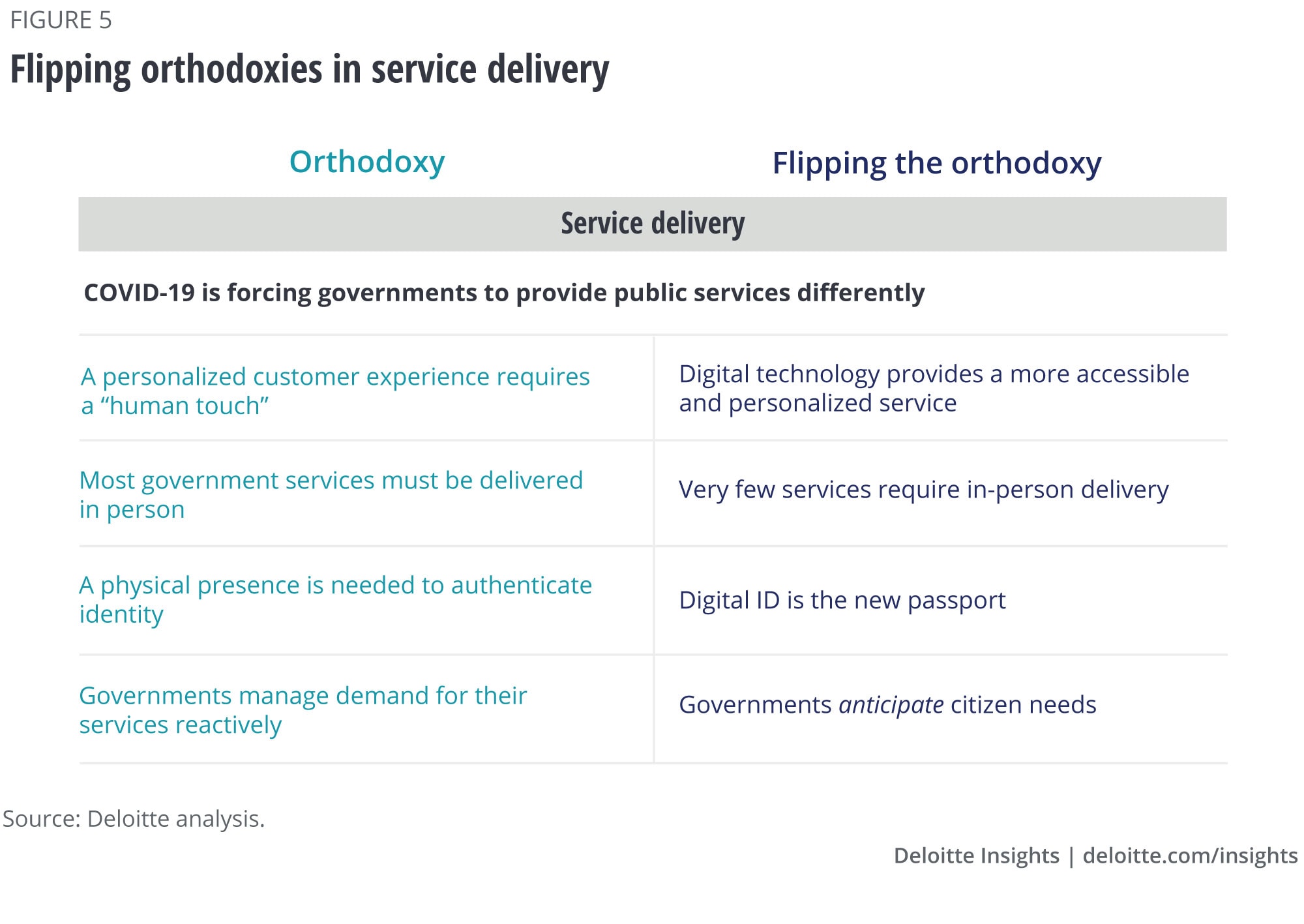
Orthodoxy 5: A personalized customer experience requires a “human touch”
The ability to provide a “human touch” through a helping hand, a smiling face, and nonverbal gestures often is considered to be part of a great customer experience. Survey after survey have shown that many people still prefer using in-person government services due to privacy and security concerns, a lack of digital skills, and a simple desire for human connection.34
According to a 2016 World Bank survey, most Europeans used e-government mostly to obtain information (44%), not for completing transactions. Before COVID-19, only 29% had filled out an online government form.35 A 2019 report found that in Australia, about 300 million government transactions out of 1,100 million, or nearly 27%, happened exclusively through traditional nondigital channels.36
Flipping the orthodoxy: Digital technology provides a more accessible and personalized service.
The best digital applications tend to have some features in common: they’re simple, intuitive, hassle-free, and personalized. They focus on solving a problem rather than delivering a service. They involve users in their creation and rely on a constant stream of user data to improve the experience. Bringing all these capabilities together can enable governments to deliver countless services in a better, more personalized way than in-person encounters.
In response to the ongoing crisis, for example, the Indian government has created “CovidIndiaSeva,” an interactive Twitter-based platform providing customized responses to live queries. At its back end, the system converts large numbers of tweets to resolvable tickets and assigns them to relevant teams of experts.37 The Spanish government’s Hispabot, an AI-powered chatbot, can provide answers to more than 200 questions, ranging from details on symptoms to Ministry of Health updates and local emergency numbers.38 The Australian Taxation Office (ATO) uses virtual assistants to provide customized responses to citizen queries. By using voice biometrics technology to quickly identify taxpayers, ATO has shaved about 40 seconds from each call, resulting in cost savings and superior service.39
Digital services can be tailored to address the needs of vulnerable citizens. For instance, in response to COVID-19, the United Kingdom has invested in 18 innovative digital solutions that support vulnerable people who need to stay at home or need other help in the community. One of these projects can help caregivers identify health risks and deterioration in geriatric patients.40 An existing service already used in New Zealand, SmartStart, provides new parents with a range of digital services during pregnancy and the months following birth, including establishing a digital identity for each child. SmartStart has saved new parents many thousands of in-person visits to government offices.41
While the pandemic is accelerating the availability of online citizen services, data connectivity and digital literacy will be crucial to make them useful, secure, and robust. Governments should assess existing digital infrastructure to identify blockages that disrupt service delivery during emergencies and revise their connectivity strategies to ensure accessibility for all.
Orthodoxy 6: Most government services must be delivered in person
Historically, certain government services—driving tests, court proceedings, inspections, social worker visits—have always been conducted in person. For instance, all US states require in-person applications for new driver’s licenses; only 10 states allow applicants to prefill their application information online.42 Due to social distancing rules and safety concerns, it’s no longer practical to deliver many of these services in the same way. These and other services should become as contactless as possible.
Flipping the orthodoxy: Very few services require in-person delivery.
The pandemic is forcing governments to shift an array of in-person services online, scaling previous pilots or innovating new online approaches from scratch. In 2016, for example, the UK government piloted an ambitious program to digitize its judicial processes. The pilots, while promising, were never scaled. The pandemic, however, prompted the government to rapidly scale the digital courts approach; the number of cases heard by video or teleconference has risen by 800% since the pandemic.43
The US Supreme Court is hearing arguments online through teleconferencing platforms for the first time.44 In British Columbia, courts have introduced mandatory pretrial conference calls for criminal, family, and small claims trials; and telephone calls and videoconferencing for ordinary, noncustody matters and case conferences.45
Estonia is home to one of the world’s most advanced e-court models. Estonian courts now handle double the number of court cases they did 20 years ago, and with the same number of judges.46 Estonia uses AI-based algorithms to sift through legal documents and other relevant information to inform decisions on small claims disputes of 7,000 euros (roughly US$8,000) or less. Such efforts have made its e-justice system one of the most effective in Europe. Estonian court proceeding processes are 32% faster than the European average.47
The crisis also has accelerated the availability of digital services offered by motor vehicle offices. In California, 97% of the Department of Motor Vehicle transactions now can be completed online, at home, or at remote kiosks and other automated locations.48 Driving- and vehicle-licensing offices that are reopening are prioritizing appointments for services that can be conducted only in person.
The United Kingdom’s Driver and Vehicle Licensing Agency (DVLA) has piloted an AI-powered chatbot to improve efficiency and provide better services. The chatbot project reduced handling times from eight minutes to 2.5 minutes, resolved 25–30% of queries entirely, and had a customer satisfaction rate of more than 90%. The success of the pilot project has made chatbots a strategic tool for the DVLA.49
A regional transport office in the state of Uttarakhand in India has even piloted an AI-powered, smartphone-based driving test system to issue driver’s licenses and reduce the need for human evaluators.50 Such innovations can aid in reducing the demand for “in-person” interactions in these offices, thus helping to maintain social distancing.
Orthodoxy 7: A physical presence is needed to authenticate identity
For decades, governments have relied on a sprawling patchwork of systems to identify and manage people, relying heavily on physical presence for verification and authentication. These services have strained governments financially and increased friction in citizen-government interactions. In the pandemic, governments need an alternative.
Flipping the orthodoxy: Digital ID is the new passport.
Many governments have found that “digital citizenship” programs are immensely beneficial, solving the “last mile” problem and delivering services effectively to the jurisdictions and individuals that need them the most.
India’s Aadhaar program, the world’s largest digital identity program, assigns a unique 12-digit identifier to each of the nation’s 1.3 billion citizens based on their biometric and demographic data. The Jan Dhan-Aadhaar-Mobile initiative, which links bank accounts to citizens’ mobile numbers and Aadhaar credentials, is being used to disburse COVID-19 cash relief.51 The average usage of this Aadhaar-enabled payment system doubled to 11.3 million per day during the lockdown period, disbursing 280 billion rupees to more than 300 million beneficiaries.52
Governments that don’t have digital identity systems are working quickly to build them. The pandemic prompted South Korea to accelerate its migration to digital identification and electronic certificates. Its government will allow financial firms to use digital certificates to verify customers by the end of the year. It’s also working with telecom companies to expand digital verification services through a “Pass” mobile app that allows users to log in to various websites with a phone number.53 Argentina is expediting the issuance of mobile-based digital IDs to ensure continued access to citizen services. Citizens who need a digital ID can send a request and, upon approval, receive an activation code and instructions on their smartphones. The virtual credential will be valid for 30 days after the end of the quarantine period.54
Digital identities are quickly being adopted by departments that have traditionally relied on physical identification practices. For instance, in New South Wales (NSW), Australia, a digital driver’s license not only means the whole renewal process can be a digital experience but also allows shops and businesses to validate identity digitally, such as checking age.55 Further, NSW also introduced a temporary provision to allow videoconferencing technologies to be used for witnessing legal documents such as power of attorney, wills, and other statutory documents.56
As digital identity systems proliferate, they will be exposed to new challenges from cybercriminals and obsolete regulations. Governments also will need to consider how to distribute digital ID systems throughout the population equitably.
Orthodoxy 8: Governments manage demand for their services reactively
A citizen who enters data correctly, follows the right processes, and trusts the system demands limited effort from the government. On the other hand, a citizen who doesn’t understand the data entry process, enters through the wrong pathway in the system, or frequently calls and emails to check on his or her status, can end up generating a multitude of additional tasks for workers. And when there are millions of customers, even five minutes of additional time for each customer means a lot of delay—for a million customers, it could entail 40 years of extra tasks for caseworkers.
These problems can result in massive backlogs and strains on government resources. Many government websites struggled under the landslide of benefits claims filed in the first week of April.
Flipping the orthodoxy: Governments anticipate citizen needs.
Governments can better manage the digital demand for services—while improving the customer experience they offer—by anticipating citizen needs. Soon after the COVID-19 outbreak, the South Korean government not only ramped up its supply of masks but also built applications that displayed the number of masks available at nearby locations.57
Some governments have invested in digital infrastructure that provides routine citizen services proactively. Swedish taxpayers, for instance, receive a prefilled tax return prepared from income statements from employers and banks, reducing the time they must devote to filing.58
Other nations provide “no-touch” services that don’t require any citizen input. In Austria, as long as all the necessary information is available, citizens don’t have to complete a form or perform any other action to receive a family allowance upon the birth of a child. The birth triggers data transfers from the hospital to the central civil registry to the ministry of finance to local tax offices, which disburse the allowance.59
Pace
The new COVID-19 reality: Governments need to act quickly and adjust rapidly to feedback
Initial delays and inaction during the pandemic caused deep problems in many parts of the world. Early shortages of supplies put front-line workers in danger. Many nations lost their chance to contain the pandemic at its infancy and now struggle to keep pace with the virus.60
After initial hiccups, however, COVID-19 pushed many governments to respond rapidly and nimbly. South Korea got testing kits on the ground in record time.61 China built hospitals in 10 days.62 Infected people were being tracked within hours in Singapore.63 The pandemic has shown that governments can embrace agility in a crisis. Regulations to restart businesses, reopen public services, and rejuvenate the economy are being developed and updated regularly in response to the global outbreak. In the postpandemic world, citizens will expect the same kind of agility in all government processes and services (figure 6).
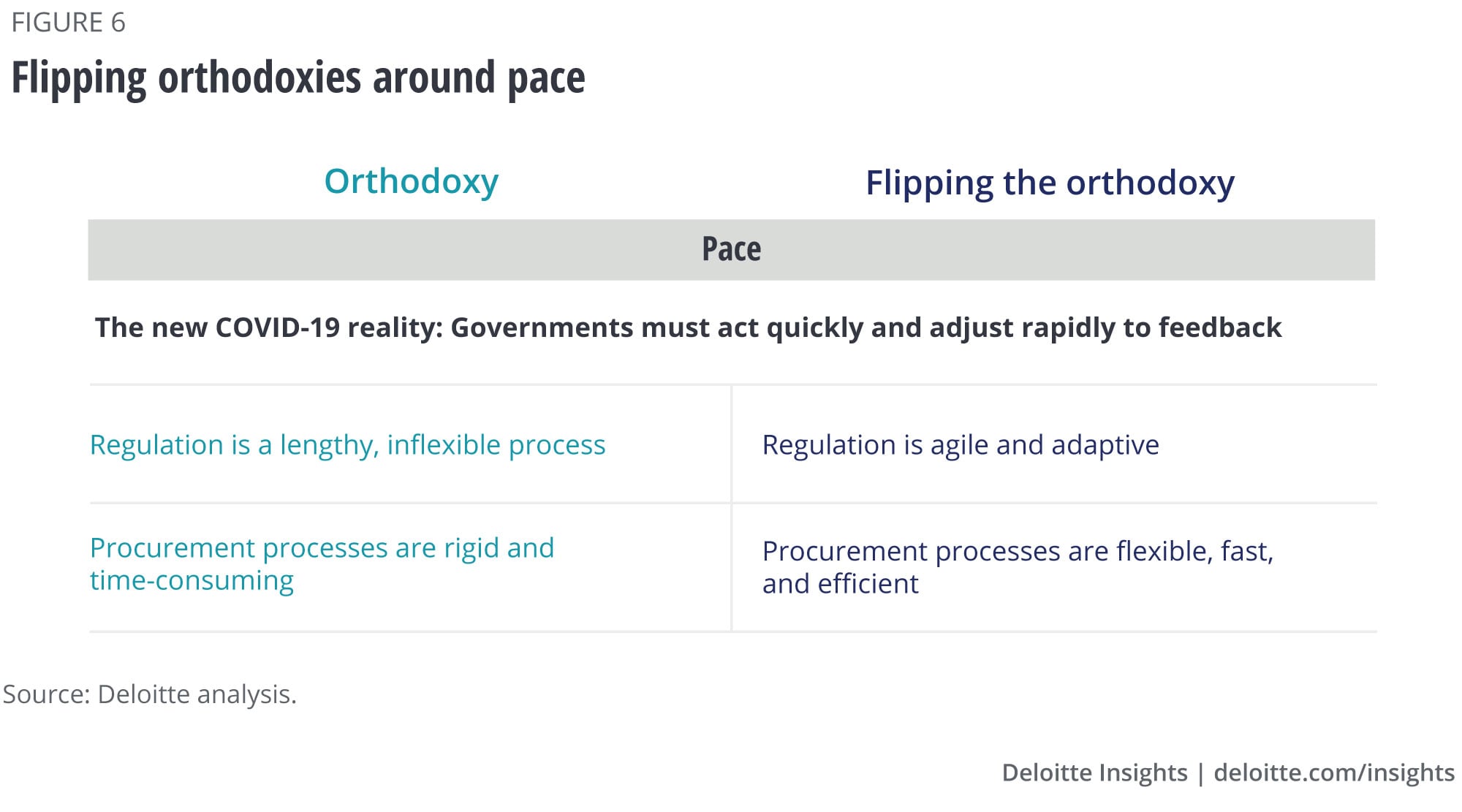
Orthodoxy 9: Regulation is a lengthy, inflexible process
Traditionally, policymakers and regulators create new rules and regulations in response to market developments or new legislation. Next, they spend months and sometimes years in drafting regulations and obtaining public comment. Finally, after multiple iterations and deliberations, the final regulation emerges.
The problem with this process is twofold: First, the regulations may be obsolete by the time they’re enacted; second, rules are rarely reconsidered once in effect. A Deloitte analysis of the 2017 US Code of Federal Regulations, for example, found that 68% of federal regulations have never been updated.64 This “regulate and forget” approach can leave regulatory agencies vulnerable in a crisis.
Flipping the orthodoxy: Regulation is agile and adaptive.
The rapid spread of COVID-19 has forced policymakers to respond with uncharacteristic swiftness. Many nations passed laws and promulgated regulations in record time.65 In the United States, for instance, the Food and Drug Administration is granting Emergency Use Authorizations to allow unapproved medical products (e.g., drugs, medical devices, personal protective equipment, and test kits) or unapproved uses of approved medical products to get out to the American public quickly.66 The United Kingdom also issued emergency notifications in April to allow national and local NHS entities to share and process confidential patient data for six months.67 Many regulators have adopted “soft laws” in the form of guidelines and standards to bring much-needed agility to the process. For instance, Public Health England and the UK Department for Businesses, Energy, and Industrial Strategy have issued a series of advisories on employee safety and financial support available to businesses to tackle the pandemic.68 Such nonbinding soft laws allow regulators to adapt to fast-moving disruptions and tackle them quickly.
For businesses to thrive, agile regulation will be crucial in the postpandemic world. Business models are changing rapidly, and regulators will need to keep pace with these changes without stifling innovation. To do so, agencies can create regulatory sandboxes, crowdsource, and accommodate industry representation in the governance process via self-regulatory and private standard-setting bodies.
Such regulatory approaches are already emerging. The Insurance Regulatory and Development Authority of India launched a sandbox for insurance providers and allowed Digit Insurance, an insurance provider based in Bengaluru, to introduce a need-based insurance product tailored to COVID-19 needs. Such testbeds for experiments can encourage innovation for new products and business models.69
Orthodoxy 10: Procurement processes are rigid and time-consuming
Traditionally, government procurement processes are careful and slow, involving multiple layers of screening and approvals from various parties. Canada’s former CIO, Alex Benay, says, “It takes around three years to create requirements and another two to purchase solutions.”70
Flipping the orthodoxy: Procurement processes are flexible, fast, and efficient.
COVID-19 has demonstrated that governments can procure much more quickly—if they have to. The emergency has caused various countries to streamline their acquisition processes. Chile’s framework to expedite essential procurements during the emergency involves buying from a roster of suppliers selected by ChileCompra, the central purchasing body.71 To accelerate procurement, India’s government e-procurement platform introduced a dedicated government buying portal for all COVID-19-related procurements. The average bid time to procure goods and services worth more than 500,000 rupees is usually two weeks; the platform reduces this to three days, with delivery in just two days.72 Regions also have come together to strengthen their bargaining power amid the pandemic. Seven US states, for instance, collectively purchased personal protective equipment, ventilators, medical tests, and other medical gear.73
COVID-19 provides an opportunity to reexamine acquisition and procurement processes, making them faster and more agile, not only in emergencies but in normal times as well. The US Navy has accelerated its acquisition time by 32% since last year. With the help of detailed supply chain data, the Navy is ensuring efficiency even as 95% of its staff works remotely.
“There are processes … working much more efficiently now than they were before, so I want to capture those,” says James Geurts, assistant secretary of the Navy for Research, Development, and Acquisition. Geurts says the Navy won’t go back to business as usual when the pandemic is over; instead, it will fundamentally change the way acquisitions are made. “We cannot operate the way we used to operate, which had a lot of fragility and brittleness, as we’re seeing right now,” he says. “It’s got to drive to the way we need to operate in the future, which has to have resiliency for whatever disruption that might come up. That’s what we’re really trying to watch closely and think two or three phases ahead.”74
Through strategic partnerships with the private sector, governments can capitalize on areas where business and social incentives align. For governments, this can ensure better cost management and greater efficiency.75
Governments should consider various new methods and technologies to fast-track their procurement processes, with an agile mindset and faster feedback loops to improve outcomes.
Beyond normal
Governments aren’t going to be returning to business as usual. The window of opportunity is open right now, and leaders can make sure the recovery leads to a brighter future.
At this moment, it’s unclear how far societal changes will go and how long they’ll take. In part, this will be determined by the virus, its depth, and duration. But it will also be shaped by government leaders and their willingness to embrace new orthodoxies and facilitate the changes needed to go “beyond normal”—maximizing performance in a continually evolving environment, anticipating change, and acting quickly.
© 2021. See Terms of Use for more information.
More on COVID-19
-
The heart of resilient leadership: Responding to COVID-19 Article5 years ago
-
The essence of resilient leadership: Business recovery from COVID-19 Article4 years ago
-
COVID-19 return-to-the-workplace strategies Article4 years ago
-
The futures of mobility after COVID-19 Article4 years ago
-
Confronting the crisis Article4 years ago
-
COVID-19 insights Collection
















